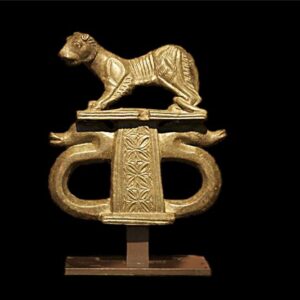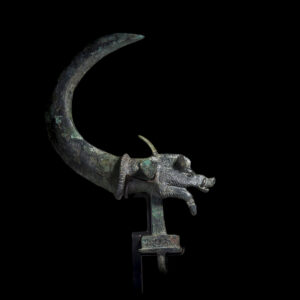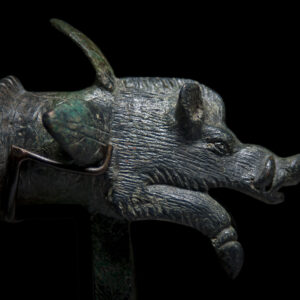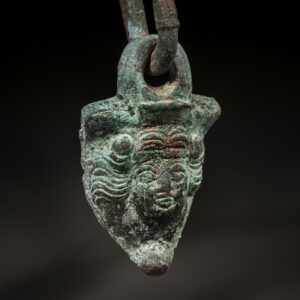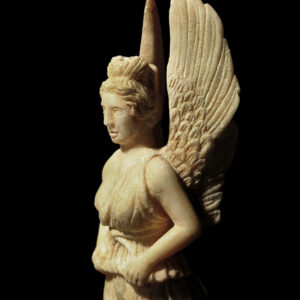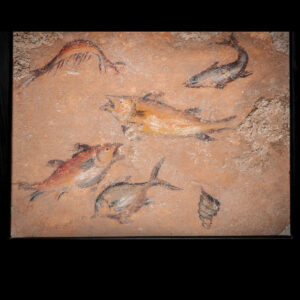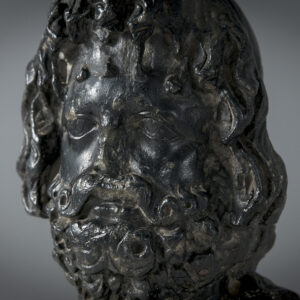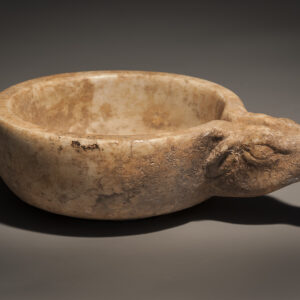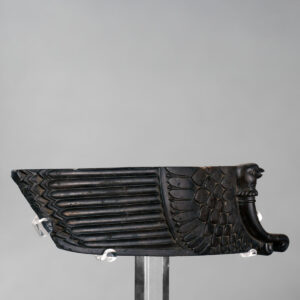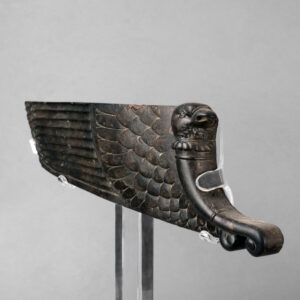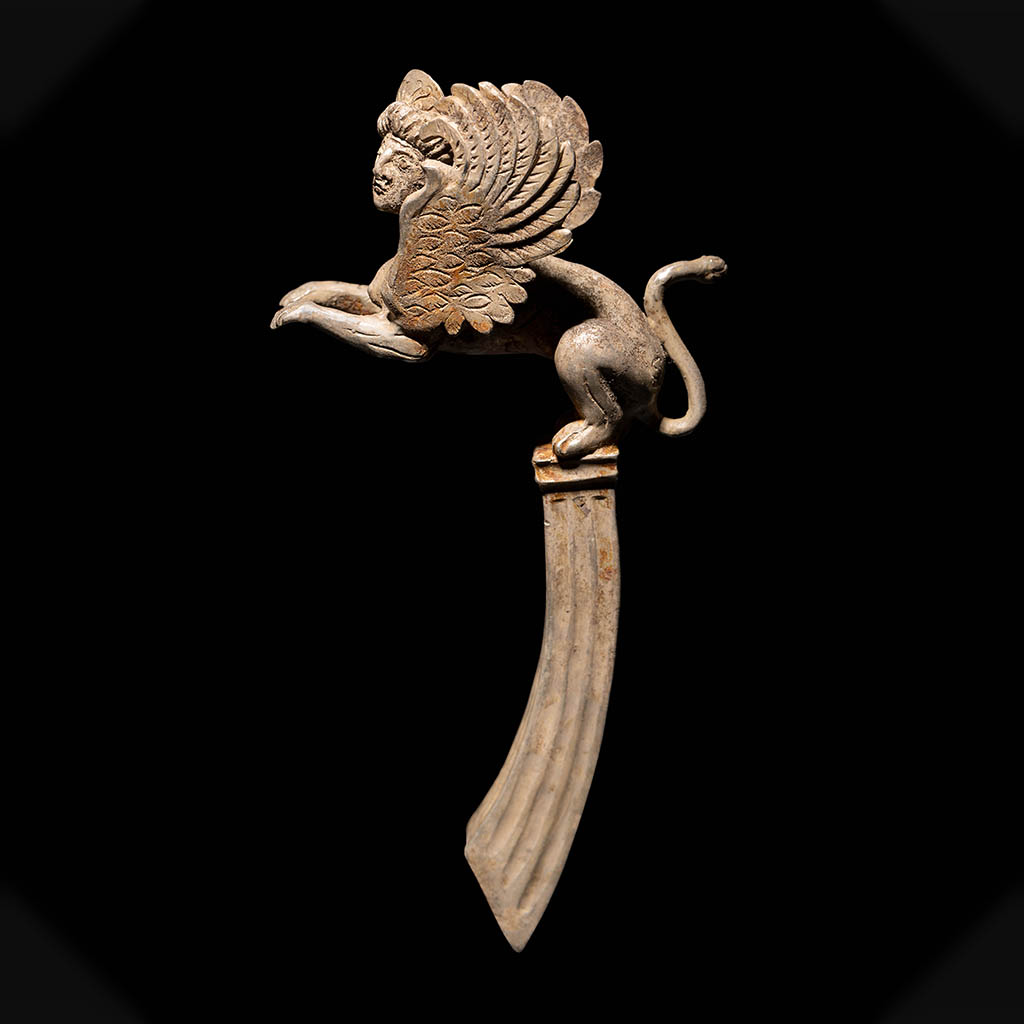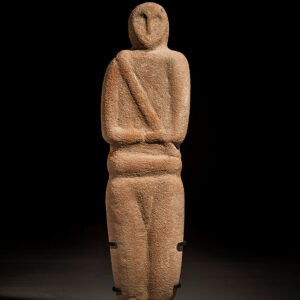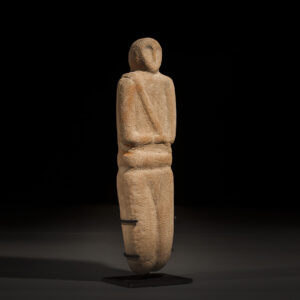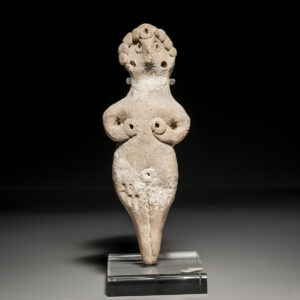Showing 33–46 of 46 results
Roman Bronze Phalera
This impressive bronze Roman phalera exemplifies the craftsmanship and symbolic artistry of ancient Roman metalworkers. The circular disk features an intricate high-relief depiction of a classical figure, possibly a deity or mythological character, rendered with expressive detail and dynamic flowing hair. The bronze surface exhibits a rich patina, with hues of green and brown indicating its ancient provenance and the natural weathering process over centuries.
The phalera, would have been used as a decorative ornament on military uniforms or horse harnesses, serving both decorative and symbolic purposes. The finely detailed relief showcases the artisan’s skill in metalwork, with carefully modeled features that convey strength and character.
REFERENCE #
SI_RM_1110
CIVILIZATION
Roman, 100 C.E. – 200 C.E.
SIZED. 8cm
CONDITION
Excellent condition.
PRICE
$8995
Roman Pompeian Wall Fresco with Aquarium-like Swimming Fish
The origins of fresco painting are unknown, but it was used as early as the Minoan civilization (at Knossos on Crete) and by the ancient Romans (at Pompeii). The Italian Renaissance was the great period of fresco painting, as seen in the works of Cimabue, Giotto, Masaccio, Fra Angelico, Correggio and many other painters from the late 13th to the mid-16th century.
Fresco is a technique of mural painting executed upon freshly-laid lime plaster. Water is used as the vehicle (or medium) for the pigment, and with the setting of the plaster the painting becomes an integral part of the wall.
Roman Pompeian Wall Fresco – 3rd Style (Period)
This extremely fine fresco is an exquisite example of ancient Roman art, originates from Pompeii in ancient Rome, and is of the 3rd Pompeian Style that was popular 20-10 BCE. This 3rd Pompeian Style (and Period) emerged and developed as a reaction to the austerity of the previous period. It leaves room for more figurative and colorful decoration, with an overall more ornamental feeling, and often presents great finesse in execution. This style is typically noted as simplistically elegant.
One who beholds this fresco today wonders if the ancient Romans were making a first proto-attempt to illustrate the conceived notion of an aquarium before the advent of modern glass and other technologies that would make the invention of aquariums actually possible in the 19th century CE. It seems that the artist who painted this fresco was attempting to create a calm and relaxing environment for those who sat in the room whose walls were decorated with this fresco of swimming fish in an Aquarium-like motif – which was extremely innovative and insightful to have the foresight in his/her day 19 centuries before the advent and invention of glass aquariums!
Pompeii Destroyed by Volcanic Eruption of Vesuvius
On 24 August 79 CE, the city of Pompeii was destroyed by the violent eruption of the volcano Vesuvius. The eruption destroyed the city, killing its inhabitants and burying it under tons of ash. The circumstances of their destruction preserved their remains as a unique document of Greco-Roman life. Pompeii supported between 10,000 and 20,000 inhabitants at the time of its destruction. Fortunately for this Fresco, it also has survived and has remained intact in Fine Condition. Provenance is excellent: acquired in the 1980s, Ex. Private Swiss Collection.
The ruins at Pompeii were first discovered late in the 16th century CE by the architect Domenico Fontana. Herculaneum was discovered in 1709 CE, and systematic excavation began there in 1738 CE. Work did not begin at Pompeii until 1748 CE, and in 1763 CE an inscription (“Rei publicae Pompeianorum”) was found that identified the site as Pompeii. The work at these towns in the mid-18th century marked the start of the modern science of archaeology.
Mount Vesuvius erupted 24 August 79 CE. A vivid eyewitness report is preserved in two letters written by Pliny the Younger to the historian Tacitus, who had inquired about the death of Pliny the Elder, commander of the Roman fleet at Misenum. Site excavations and volcanological studies, notably in the late 20th century CE.
Just after midday on 24 August, fragments of ash, pumice, and other volcanic debris began pouring down on Pompeii, quickly covering the city to a depth of more than 9 feet (3 metres) and causing the roofs of many houses to fall in. Surges of pyroclastic material and heated gas, known as nuées ardentes, reached the city walls on the morning of 25 August and soon asphyxiated those residents who had not been killed by falling debris. Additional pyroclastic flows and rains of ash followed, adding at least another 9 feet of debris and preserving in a pall of ash the bodies of the inhabitants who perished while taking shelter in their houses or trying to escape toward the coast or by the roads leading to Stabiae or Nuceria.
Thus Pompeii remained buried under a layer of pumice stones and ash 19 to 23 feet (6 to 7 metres) deep. The city’s sudden burial served to protect it for the next 17 centuries from vandalism, looting, and the destructive effects of climate and weather.
REFERENCE #
SW_MS_1103
CIVILIZATION
Roman, Pompeii 3rd Period, 100
SIZE
31 cm x H. 36.5 cm
CONDITION
Fine condition
PRICE
Price available upon request
PROVENANCE
Ex. Private Swiss collection, Acquired 1980s
Schist Achamaenid Wing With Phoenix
This schist wing, dating from the Achaemenid period circa 500–300 BC and measuring approximately 27.5 centimeters, exemplifies the sophisticated craftsmanship and symbolic motifs of the era. The carved stone fragment depicts a stylized wing, notable for its intricate workmanship and symbolic significance. Central to the design is a finely incised and carefully modeled relief of a phoenix, a mythological bird emblematic of renewal, immortality, and divine protection—an iconic motif in Persian art. The detailed depiction demonstrates the skillful use of incisions and relief carving, highlighting the artisans’ mastery of stonework.
Originally, this fragment would have been part of an elaborate furniture decoration, potentially serving as a decorative panel or ornament within a throne, throne room, or ceremonial setting. The use of schist, a durable and locally sourced stone, reflects both aesthetic preferences and the technical capabilities of Achaemenid artisans. The phoenix motif underscores themes of rebirth and divine authority, aligning with the rich iconography prevalent in Persian cultural and religious symbolism.
Today, this fragment preserves the fine craftsmanship and sophisticated iconography characteristic of Achaemenid decorative arts. Its preserved details provide valuable insights into the visual language and ceremonial ornamentation of the Persian elite, illustrating the grandeur and symbolic complexity that adorned the architecture and surroundings of the ruling class in the ancient empire. REFERENCE #
SI_PR_1019
CIVILIZATION
Persian, 500 B.C.E.
SIZE
H. 27.5cm
CONDITION
Fine Condition
PRICE
$27500
PROVENANCE
Jerusalem Private Collection, late 1970’s.
Silver Pair of Sphinx Handles
Two handles from a bowl, pot or goblet. The square section is hollow and convex in shape to make holding the vessel easier. Each handle terminates in a sphinx standing on its back legs, with its front paws outstretched. These would be the point where the handles were attached to the upper area of the vessel.
The sphinxes are identical apart from the fact that one head looks to the left and the other to the right, although not quite to the same degree. They are depicted according to the Greek social conception of this mythological creature. Each has the bust of a woman, the body and tail of a lion, great bird wings and a female human head. Each head is depicted wearing a diadem and with the hair swept up and held at the back of the head in a bun. The precision and detail of the working of the faces and wings is notable, giving a sense of movement and realism to the pair. One can appreciate a clear attempt to differentiate between the feathers of the wings: those inserted into the body itself are small and short, rather like scales, while those at the extreme end of the wings are long and narrow, to help the creature take flight.
According to ancient literary sources, the sphinx was a monster with the face and bust of a woman, the claws of a lion, the body of a dog, the tail of a snake and wings of a bird. This demon of divine origin, whose presence excited uncertainty and terror in humans, was also characterized by its pallid appearance, fiery look and venomous mouth. It’s possible that this hybrid had its origin in Egyptian iconography, where it was represented with a feline body and human face, possibly connected to the divine power of the pharaoh.
The sculptural prototype of Greek sphinxes appears around the 7th century BCE in terracotta and was usually found decorating large receptacles. A century later they appeared in marble crowning seated ex-votos on a column. The monstrous, aggressive nature of the hybrid was channelled into funerary art, serving as an apotropaic symbol to keep away malevolent forces. It was usual, therefore, to find this iconography in metopes and hollow acroteria in Greek necropoleis of the 6th century BCE, usually with the animal in profile and turning its head toward the public in an attitude of defiance.
Reference #
SI_GR_1034
Civilization Greek,
5th – 4th century B.C.E.
Size
H. 14 cm
Condition
Intact, Fine
Price
P.O.R.
Provenance
Private collection, Great Britain. Acquired before 1975
Statuette of an Idol
Pink statuette of Sabaean idol with stylized representation for the eyes and nose set on an oval face. Rectangular body is marked by diagonal sash running along torso. Arms are folded at right angles from the shoulders, set above belted waist and smooth legs.
REFERENCE #
SI_SA_1015
CIVILIZATION
Sabaean, 3000 B.C.E. – 2000 B.C.E.
SIZE
H. 39 cm
CONDITION
Fine condition
PRICE
Sold
PROVENANCE
Former Swiss private collection, acquired ca. 1980.

